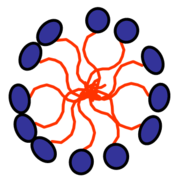Surfactant
From Wikipedia, the free encyclopedia
Surfactants are wetting agents that lower the surface tension of a liquid, allowing easier spreading, and lower the interfacial tension between two liquids.
Contents |
Etymology
The term surfactant is a blend of surface active agent[1]. Surfactants are usually organic compounds that are amphiphilic, meaning they contain both hydrophobic groups (their "tails") and hydrophilic groups (their "heads"). Therefore, they are soluble in both organic solvents and water. The term surfactant was coined by Antara products in 1950.
In Index Medicus and the United States National Library of Medicine, "surfactant" is reserved for the meaning pulmonary surfactant. For the more general meaning, "surface active agent" is the heading.
Properties

Surfactants reduce the surface tension of water by adsorbing at the liquid-gas interface. They also reduce the interfacial tension between oil and water by adsorbing at the liquid-liquid interface. Many surfactants can also assemble in the bulk solution into aggregates. Examples of such aggregates are vesicles and micelles. The concentration at which surfactants begin to form micelles is known as the critical micelle concentration or CMC. When micelles form in water, their tails form a core that can encapsulate an oil droplet, and their (ionic/polar) heads form an outer shell that maintains favorable contact with water. When surfactants assemble in oil, the aggregate is referred to as a reverse micelle. In a reverse micelle, the heads are in the core and the tails maintain favorable contact with oil. Surfactants are also often classified into four primary groups; anionic, cationic, non-ionic, and zwitterionic (dual charge).
Thermodynamics of the surfactant systems are of great importance, theoretically and practically. This is because surfactant systems represent systems between ordered and disordered states of matter. Surfactant solutions may contain an ordered phase (micelles) and a disordered phase (free surfactant molecules and/or ions in the solution).
Ordinary washing up (dishwashing) detergent, for example, will promote water penetration in soil, but the effect would only last a few days (many standard laundry detergent powders contain levels of chemicals such as sodium and boron, which can be damaging to plants and should not be applied to soils). Commercial soil wetting agents will continue to work for a considerable period, but they will eventually be degraded by soil micro-organisms. Some can, however, interfere with the life-cycles of some aquatic organisms, so care should be taken to prevent run-off of these products into streams, and excess product should not be washed down.
Applications and sources
Surfactants play an important role in many practical applications and products, including:
- Detergents
- Fabric softener
- Emulsifiers and Emulsions
- Paints
- Adhesives
- Inks
- Anti-fogging
- Soil remediation
- Dispersants
- Wetting
- Ski wax, snowboard wax
- Deinking of recycled paper, both in flotation, washing and enzymatic processes
- Foaming agents
- Defoamers
- Laxatives
- Agrochemical formulations
- Quantum dot coating
- Biocides (sanitizers)
- Shampoo
- Hair conditioners (after shampoo)
- Spermicide (nonoxynol-9)
- Firefighting
- Pipeline, Liquid drag reducing agent
- Alkali Surfactant Polymers (used to mobilize oil in oil wells)
- Ferrofluids
- Leak Detectors
Pulmonary surfactants are also naturally secreted by type II cells of the lung alveoli in mammals.
[edit] Classification
A surfactant can be classified by the presence of formally charged groups in its head. A non-ionic surfactant has no charge groups in its head. The head of an ionic surfactant carries a net charge. If the charge is negative, the surfactant is more specifically called anionic; if the charge is positive, it is called cationic. If a surfactant contains a head with two oppositely charged groups, it is termed zwitterionic.
Some commonly encountered surfactants of each type include:
- Ionic
- Anionic (based on sulfate, sulfonate or carboxylate anions)
- Perfluorooctanoate (PFOA or PFO)
- Perfluorooctanesulfonate (PFOS)
- Sodium dodecyl sulfate (SDS), ammonium lauryl sulfate, and other alkyl sulfate salts
- Sodium laureth sulfate, also known as sodium lauryl ether sulfate (SLES)
- Alkyl benzene sulfonate
- Soaps, or fatty acid salts
- Cationic (based on quaternary ammonium cations)
- Cetyl trimethylammonium bromide (CTAB) a.k.a. hexadecyl trimethyl ammonium bromide, and other alkyltrimethylammonium salts
- Cetylpyridinium chloride (CPC)
- Polyethoxylated tallow amine (POEA)
- Benzalkonium chloride (BAC)
- Benzethonium chloride (BZT)
- Zwitterionic (amphoteric)
- Anionic (based on sulfate, sulfonate or carboxylate anions)
- Nonionic
- Alkyl poly(ethylene oxide)
- Alkylphenol poly(ethylene oxide)
- Copolymers of poly(ethylene oxide) and poly(propylene oxide) (commercially called Poloxamers or Poloxamines)
- Alkyl polyglucosides, including:
- Fatty alcohols
- Cocamide MEA, cocamide DEA
- Polysorbates: Tween 20, Tween 80
Health and environmental controversy
Some surfactants are known to be toxic to animals, ecosystems and humans, and can increase the diffusion of other environmental contaminants.[2][3][4] Despite this, they are routinely deposited in numerous ways on land and into water systems, whether as part of an intended process or as industrial and household waste. Some surfactants have proposed or voluntary restrictions on their use. For example, PFOS is slated for persistent organic pollutant (POP) status by the Stockholm Convention.[5] Additionally, PFOA has been subject to a voluntary agreement by the U.S. Environmental Protection Agency and eight chemical companies to reduce and eliminate emissions of the chemical and its precursors.[6] However, other industries operate outside of the voluntary PFOA program.[7]

No comments:
Post a Comment